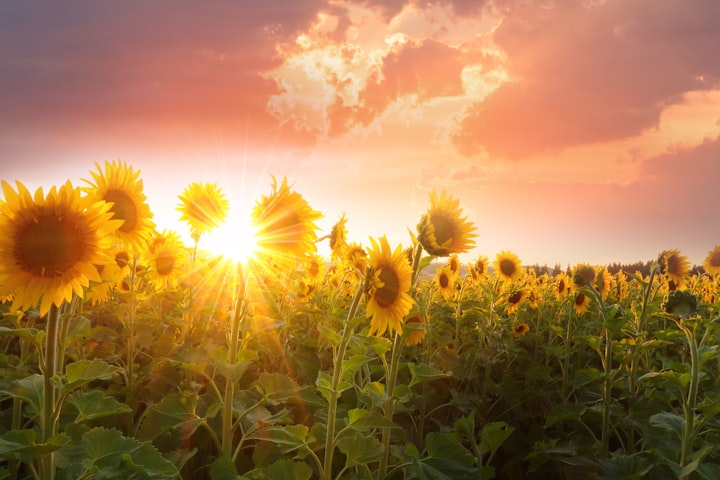The Four Seasons: Appreciating the Beauty and Wonder of Nature's Changing Cycles
Exploring the Unique Characteristics of Spring, Summer, Fall, and Winter

Four Seasons: The Beauty and Wonder of Nature's Changing Cycles
As the Earth orbits the sun, the planet's axial tilt causes different parts of the globe to receive varying amounts of sunlight throughout the year. This phenomenon gives rise to the four seasons: spring, summer, fall, and winter. Each season has its own unique characteristics, from the vibrant blossoms of spring to the serene snowscapes of winter. The four seasons offer a visual feast for the senses, as well as an opportunity to appreciate the beauty and wonder of nature's changing cycles.
Spring
Spring is a time of renewal and rejuvenation, as the snow melts and the world awakens from its winter slumber. The trees begin to bud, and the first flowers of the year start to bloom. Birds return from their winter migrations, filling the air with their joyful songs. The days grow longer, and the air warms, bringing new life to the world around us.
The season of spring marks the transition from winter to summer. In the Northern Hemisphere, spring typically starts in late March and lasts until late June. In the Southern Hemisphere, spring runs from September to December. The arrival of spring is often eagerly anticipated, as it brings a sense of hope and renewal after the long, dark months of winter.

One of the most notable characteristics of spring is the emergence of new growth. After the dormancy of winter, plants and trees begin to bloom, filling the landscape with vibrant colors and sweet fragrances. Spring flowers, such as daffodils, tulips, and hyacinths, are among the first to bloom, followed by cherry blossoms and apple blossoms. Trees also begin to sprout new leaves, adding a fresh green hue to the surroundings.
Spring is also a time of change and transition. As the snow melts, rivers and streams swell with water, creating a new energy in the landscape. The season is also marked by frequent rain showers, which help to nourish the newly emerging plants and trees. With the arrival of spring, the days become longer and warmer, allowing us to spend more time outside and enjoy the natural beauty of the world around us.
Summer
Summer is a time of warmth and vitality, as the sun reaches its highest point in the sky. The fields are lush and green, and the trees are in full leaf. The days are long, and the evenings are warm, inviting us to spend more time outside. The beach beckons, and the water shimmers in the sunlight. Summer is a time of abundance and joy, a time to revel in the beauty of nature.

In the Northern Hemisphere, summer starts in late June and lasts until late September. In the Southern Hemisphere, summer runs from December to March. With the arrival of summer, the days become longer and hotter, providing the perfect conditions for outdoor activities such as swimming, hiking, and camping.
One of the defining characteristics of summer is the abundance of light and warmth. The sun is at its highest point in the sky, providing ample energy for plants and animals to thrive. The landscape is lush and green, as trees and plants soak up the sun's rays and convert them into energy. Summer also brings an abundance of fresh produce, from juicy watermelons and sweet strawberries to crisp cucumbers and flavorful tomatoes.
Summer is also a time of relaxation and rejuvenation. With longer days and warmer weather, many people take vacations or spend time outdoors with family and friends. The beach, parks, and other outdoor destinations are popular during the summer months, providing opportunities for relaxation and recreation.
Fall
Fall is a time of change, as the leaves turn brilliant shades of red, orange, and gold. The air is crisp and cool, and the days grow shorter. As the summer fades into memory, the world prepares for the arrival of winter. Fall is a season of reflection and introspection, a time to gather the harvest and prepare for the coming cold.
In the Northern Hemisphere, fall typically starts in late September and lasts until late December. In the Southern Hemisphere, fall runs from March to June. The arrival of fall is marked by the changing of the leaves, as trees shed their leaves and prepare for the winter. The landscape is transformed into a tapestry of colors, as the reds, yellows, and oranges of fall leaves provide a stunning backdrop to the world around us.

Fall is also a time of harvest and abundance. Apples, pumpkins, and other crops are ready to be picked, providing nourishment for people and animals alike. Fall also marks the return of migratory birds, as they make their way south for the winter. The air is filled with the sounds of birdsong, as the birds gather in flocks and prepare for their long journey.
As the days grow shorter, fall also brings a sense of introspection and reflection. Many people take stock of their lives and make plans for the coming year. The cooler weather provides the perfect conditions for cozy evenings spent indoors, with books, hot cocoa, and warm blankets.
Winter
Winter is a time of stillness and solitude, as the world prepares for a period of rest and rejuvenation. The landscape is transformed into a winter wonderland, as snow blankets the ground and icicles hang from the trees. The air is cold and crisp, and the days are short. Winter is a season of contrasts, as the beauty of the snow and ice is offset by the harshness of the cold.
In the Northern Hemisphere, winter typically starts in late December and lasts until late March. In the Southern Hemisphere, winter runs from June to September. With the arrival of winter, the days become shorter and colder, providing the perfect conditions for snow and ice to form.

One of the defining characteristics of winter is the snow and ice that covers the landscape. Snowflakes fall from the sky, creating a soft, white blanket on the ground. Icicles hang from trees and buildings, creating a dazzling display of light and reflection. Winter sports, such as skiing and snowboarding, are popular during this time of year, as people take advantage of the snowy conditions.
Winter is also a time of rest and rejuvenation. Many animals hibernate during the winter months, conserving their energy until the arrival of spring. People also take this time to slow down and recharge, spending time with loved ones and engaging in indoor activities such as reading, cooking, and crafting.
In conclusion, the four seasons offer a rich and diverse experience of nature's changing cycles. From the renewal of spring to the warmth of summer, the reflection of fall, and the stillness of winter, each season has its own unique characteristics and beauty. By appreciating the wonder of the changing seasons, we can deepen our connection to the natural world and gain a greater appreciation for the cycles of life.
About the Creator
Muhammad Telmeez
hey there! i'm a reader since my childhood and a writer. I read and write about health, wealth and life. I also write about human psychology and human nature.






Comments
Muhammad Telmeez is not accepting comments at the moment
Want to show your support? Send them a one-off tip.